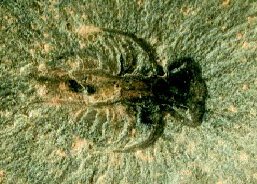Ancient critter caught shedding Its skin
A fossil reveals that ancient animals shed their skin, just as insects and crustaceans do today.
By Emily Sohn
Few people would want to ditch their skin, but some creatures have been doing it for hundreds of millions of years. An ancient fossil supplies the evidence for such skin shedding.
 |
|
This ancient insect-like sea creature was fossilized while shedding its skin.
|
| Desmond H. Collins/Nature |
Skin shedding, or molting, is common throughout a class of hard-skinned animals called arthropods. Three-fourths of all living and extinct species belong to the group, which includes crabs, insects, and scorpions. Arthropods get rid of their hard, outer skins in order to grow. You may have found empty insect shells lying around.
Arthropod fossils date back many millions of years. Previously, scientists suspected that the creatures molted, because they had found arthropod fossils near fossils of empty skins. Now, finally, there’s proof. For the first time, researchers from the Royal Ontario Museum in Toronto have found a fossil of a creature caught in the act of molting.
The specimen is a type of animal called Marrella splendens, which is related to another type of ancient creature called a trilobite. It’s 505 million years old. The researchers found the specimen among 25,000 other examples of this species collected from western Canada.
Molting fossils are rare for a couple of reasons. For one thing, a newly molted creature has soft skin, making preservation difficult. On top of that, animals spend such a short time molting that the odds are against them being fossilized during the process. The new discovery, therefore, is a huge stroke of luck.







